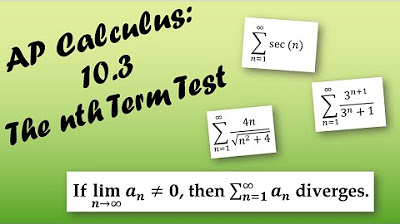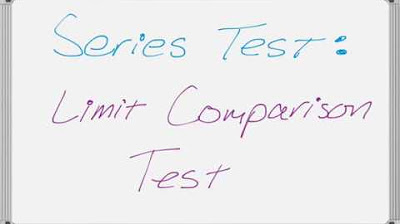nth term divergence test | Series | AP Calculus BC | Khan Academy
TLDRThe video script discusses the divergence test, a method to determine if an infinite series will diverge. It explains that if the limit of the series' terms as N approaches infinity does not equal zero, the series will definitely diverge. Examples are provided to illustrate the test's application and its limitations, emphasizing that passing the test doesn't guarantee convergence.
Takeaways
- 📚 The divergence test is a fundamental method to determine whether an infinite series will diverge, but it cannot confirm convergence.
- 🔍 If the limit of a sequence A_n as N approaches infinity does not equal zero, the series ∑_{N=1}^{∞} A_n will diverge.
- 🌐 Divergence implies the series will either go unbounded to positive or negative infinity or oscillate without settling on a specific value.
- 🧩 The series ∑_{N=1}^{∞} (4N^2 - N^3) / (7 - 3N^3) is used as an example to demonstrate the application of the divergence test.
- 🔑 By focusing on the highest degree terms, the limit of the series' general term A_n simplifies to -1/-3, which is 1/3, indicating divergence.
- 🤔 The divergence test encourages a pause for thought, prompting viewers to consider the limit of the series' general term themselves.
- 📉 For a series to converge, each additional term must approach zero as N approaches infinity; otherwise, the series will diverge.
- 🚫 The divergence test cannot confirm convergence; a limit approaching zero only indicates the test is inconclusive for divergence.
- 🔄 The harmonic series ∑_{N=1}^{∞} 1/N is an example where the divergence test is inconclusive, yet the series is known to diverge.
- 📈 The series ∑_{N=1}^{∞} 1/N^2 passes the divergence test with a limit approaching zero, but further tests are needed to confirm its convergence.
- 🛠 The divergence test is a useful tool for confirming divergence when the limit of A_n does not equal zero, but additional tests are often required to establish convergence.
Q & A
What is the divergence test used for in the context of infinite series?
-The divergence test is used to determine whether an infinite series will diverge. It can't confirm convergence, but if the limit of the series' terms as N approaches infinity does not equal zero, the series will definitely diverge.
What does it mean for a series to diverge?
-A series diverges if the sum either goes unbounded to positive or negative infinity or oscillates between values without approaching a specific sum or value.
Can you provide the mathematical notation for the divergence test?
-The mathematical notation for the divergence test is to check if the limit as N approaches infinity of A sub N does not equal zero, which would indicate that the series diverges.
How can you determine if the series ∑(4N^2 - N^3 / 7 - 3N^3) diverges?
-To determine if this series diverges, you would look at the limit of the term 4N^2 - N^3 / 7 - 3N^3 as N approaches infinity. If this limit does not equal zero, the series diverges.
What is the highest degree term of a polynomial that matters when determining the limit of a series as N approaches infinity?
-When determining the limit of a series as N approaches infinity, the highest degree term of the polynomial in both the numerator and the denominator is what matters most.
What is the limit of the series term 4N^2 - N^3 / 7 - 3N^3 as N approaches infinity?
-The limit of this term as N approaches infinity is -1/3, which is obtained by dividing the numerator and the denominator by N^3 and observing the behavior of the leading terms.
Why does the divergence test indicate that the series ∑(4N^2 - N^3 / 7 - 3N^3) diverges?
-The divergence test indicates the series diverges because the limit of the series term does not approach zero as N approaches infinity; instead, it approaches -1/3.
What is the significance of the limit of a series term approaching zero for convergence?
-For a series to converge, the terms must approach zero as N approaches infinity, indicating that each additional term contributes less and less to the sum, potentially leading to a finite sum.
Can the divergence test be used to prove that a series converges?
-No, the divergence test can only be used to show that a series diverges. If the limit of the series term as N approaches infinity equals zero, it does not necessarily mean the series converges; further tests are required.
What is an example of a series that fails the divergence test but still diverges?
-The harmonic series ∑(1/N) is an example of a series that fails the divergence test because the limit of 1/N as N approaches infinity is zero, yet the series is known to diverge.
Is there a series that passes the divergence test but still converges?
-No, if a series passes the divergence test (i.e., the limit of the series term as N approaches infinity is not zero), it must diverge. The divergence test cannot be passed by a convergent series.
What is the conclusion of applying the divergence test to the series ∑(1/N^2)?
-Applying the divergence test to the series ∑(1/N^2) shows that the limit as N approaches infinity is zero, which means the test is inconclusive for determining convergence; additional tests are needed to confirm convergence.
Outlines
🔍 Introduction to Divergence Test
This paragraph introduces the concept of the divergence test, which is a fundamental tool in mathematical analysis for determining whether an infinite series will diverge. The test is based on the limit of the series' terms as N approaches infinity. If the limit of the term A sub N is not zero, the series is guaranteed to diverge. The paragraph also explains that divergence means the series will either increase without bound to positive or negative infinity or oscillate without settling on a specific value. A concrete example is given with a series involving polynomial terms, and the process of evaluating the limit to determine divergence is discussed. The importance of terms approaching zero for convergence is highlighted, and the limitations of the divergence test are also mentioned, noting that a series can pass the test (limit approaching zero) and still diverge.
📚 Limitations and Further Insights of Divergence Test
The second paragraph delves into the limitations of the divergence test, emphasizing that a series passing the test (i.e., the limit of its terms approaching zero) does not guarantee convergence. The harmonic series is provided as an example that, despite the limit of its terms being zero, it is proven to diverge in other videos. The paragraph also points out that there are series that do converge, such as one over N squared, which also pass the divergence test. It is clarified that the divergence test is useful for confirming divergence when the limit of the series' terms does not equal zero, but additional tests are required to prove convergence. The paragraph concludes by reinforcing the idea that for a series to converge, its terms must eventually approach zero, and the divergence test is a valuable tool in identifying when they do not.
Mindmap
Keywords
💡Divergence Test
💡Converge
💡Diverge
💡Infinite Series
💡A sub N
💡Limit
💡N approaches infinity
💡Numerator
💡Denominator
💡Harmonic Series
Highlights
Introduction to the divergence test for determining if an infinite series will diverge.
Divergence test states that if the limit of A sub N as N approaches infinity does not equal zero, the series diverges.
Explanation of divergence meaning the sum goes unbounded to infinity, negative infinity, or oscillates without settling on a value.
The usefulness of the divergence test in identifying series that will definitely diverge.
Example of applying the divergence test to a candidate series with a formula for A sub N.
Analyzing the limit of a series involving N to the power of different degrees to determine divergence.
The conclusion that if the limit of A sub N as N approaches infinity is not zero, the series will diverge.
The rationale behind why a series can only converge if additional terms approach zero as N approaches infinity.
The divergence test's limitation in proving convergence, as passing the test does not guarantee convergence.
Example of the harmonic series, which passes the divergence test but is known to diverge.
The need for additional tests like the comparison test or integral test to prove divergence in certain series.
Illustration of a series with a limit approaching zero, which does not necessarily mean it converges.
Explanation that a series can converge even if it 'fails' the divergence test, as shown with the sum of one over N squared.
Clarification that the divergence test is useful for confirming divergence when the limit of A sub N does not equal zero.
Emphasis on the importance of recognizing the divergence test's limitations and the need for other tests to confirm convergence or divergence.
Transcripts
Browse More Related Video

AP Calculus BC Lesson 10.3

Series Tests - Limit Comparison Test

Worked example: limit comparison test | Series | AP Calculus BC | Khan Academy

Convergence and Divergence - Introduction to Series

Calculus BC – 10.3 The nth Term Test for Divergence

Worked example: Integral test | Series | AP Calculus BC | Khan Academy
5.0 / 5 (0 votes)
Thanks for rating: